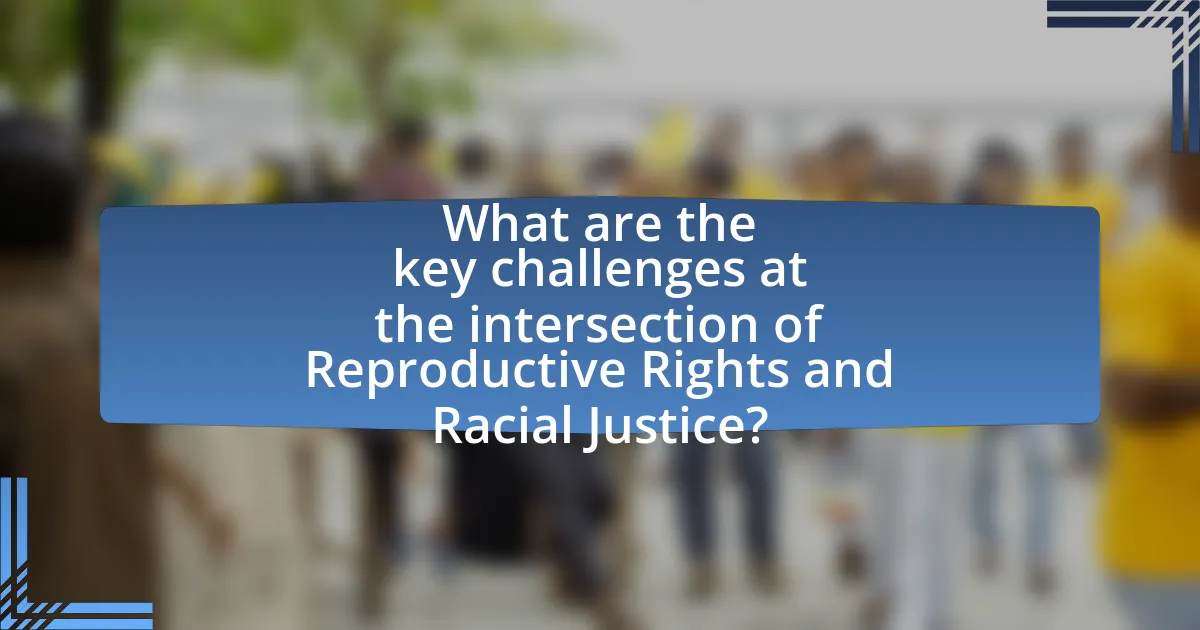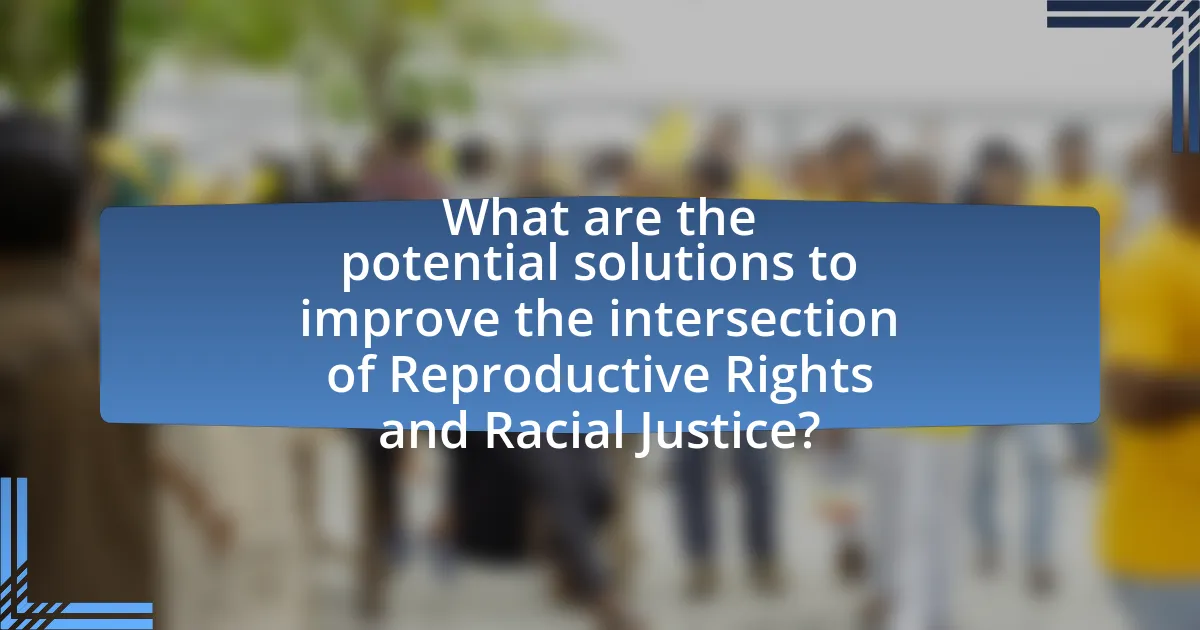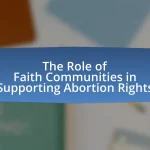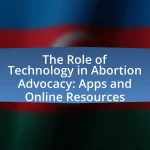The intersection of reproductive rights and racial justice examines how access to reproductive health services, such as abortion and contraception, disproportionately impacts marginalized racial and ethnic communities. Systemic racism and socioeconomic disparities create significant barriers to reproductive healthcare, leading to higher rates of unintended pregnancies and maternal mortality, particularly among Black women in the United States. Historical contexts, including the legacy of slavery and eugenics, further complicate these issues, highlighting the urgent need for equitable policies that address both racial and gender disparities. Understanding this intersection is crucial for developing effective advocacy and legislative measures aimed at improving health outcomes and ensuring reproductive rights for all individuals, regardless of race.

What is the Intersection of Reproductive Rights and Racial Justice?
The intersection of reproductive rights and racial justice refers to the ways in which access to reproductive health services, including abortion and contraception, disproportionately affects marginalized racial and ethnic communities. Research indicates that systemic racism and socioeconomic disparities limit these communities’ access to reproductive healthcare, leading to higher rates of unintended pregnancies and maternal mortality. For instance, Black women in the United States are three to four times more likely to die from pregnancy-related complications than white women, highlighting the urgent need for equitable reproductive health policies that address both racial and gender disparities.
How do reproductive rights relate to racial justice?
Reproductive rights are fundamentally linked to racial justice as they address the systemic inequalities that affect marginalized racial groups. Access to reproductive healthcare, including contraception and abortion, is often limited for people of color due to socioeconomic barriers, discriminatory policies, and historical injustices. For instance, Black women in the United States are disproportionately affected by restrictive reproductive laws and face higher rates of maternal mortality, highlighting the intersection of race and reproductive health. Studies show that when reproductive rights are restricted, the impact is felt more acutely by communities of color, exacerbating existing disparities in health outcomes and economic stability. Thus, ensuring reproductive rights is essential for achieving racial justice and equity.
What historical contexts shape the intersection of these two issues?
The historical contexts that shape the intersection of reproductive rights and racial justice include the legacy of slavery, eugenics movements, and systemic racism in healthcare. The legacy of slavery has led to a mistrust of medical institutions among communities of color, influencing their access to reproductive healthcare. Eugenics movements in the early 20th century targeted marginalized groups, promoting sterilization and limiting reproductive choices, which disproportionately affected women of color. Additionally, systemic racism in healthcare continues to create disparities in maternal and infant mortality rates, highlighting the ongoing struggle for both reproductive rights and racial justice. These contexts illustrate how historical injustices inform current challenges faced by marginalized communities in accessing reproductive healthcare.
How do systemic inequalities impact access to reproductive rights for marginalized communities?
Systemic inequalities significantly hinder access to reproductive rights for marginalized communities by creating barriers such as economic disadvantage, lack of healthcare resources, and discriminatory policies. For instance, low-income individuals often face financial obstacles that prevent them from affording reproductive healthcare services, including contraception and abortion. According to the Guttmacher Institute, women of color and those living in poverty are disproportionately affected, with 75% of women who seek abortions being low-income. Additionally, systemic racism within healthcare systems leads to inadequate care and mistrust, further complicating access. These factors collectively contribute to a landscape where marginalized communities struggle to exercise their reproductive rights fully.
Why is understanding this intersection important?
Understanding the intersection of reproductive rights and racial justice is crucial because it highlights how systemic inequalities affect access to reproductive healthcare for marginalized communities. Research indicates that women of color face significant barriers, such as socioeconomic disparities and discriminatory practices, which limit their reproductive choices. For instance, a study by the Guttmacher Institute found that Black women are more likely to experience unintended pregnancies and have less access to contraception compared to their white counterparts. This intersectional understanding is essential for developing policies that address these disparities and promote equitable healthcare access for all individuals, regardless of race.
What implications does this intersection have on policy-making?
The intersection of reproductive rights and racial justice significantly influences policy-making by highlighting the need for equitable access to reproductive healthcare across different racial and ethnic groups. This intersection reveals systemic inequalities that necessitate policies aimed at addressing disparities in healthcare access, funding for reproductive services, and comprehensive sex education. For instance, research indicates that women of color face higher rates of maternal mortality and limited access to reproductive health services, which underscores the urgency for policies that specifically target these inequities. By integrating racial justice into reproductive rights discussions, policymakers can create more inclusive frameworks that ensure all individuals receive the necessary support and resources, ultimately leading to improved health outcomes and social equity.
How does it affect the health outcomes of different racial groups?
Access to reproductive rights significantly affects health outcomes among different racial groups by contributing to disparities in maternal and infant health. For instance, Black women in the United States face a maternal mortality rate that is three to four times higher than that of white women, largely due to systemic barriers in accessing quality healthcare and reproductive services. Research from the Centers for Disease Control and Prevention (CDC) indicates that these disparities are exacerbated by factors such as socioeconomic status, healthcare access, and implicit bias within medical systems. Additionally, limited access to reproductive health services can lead to higher rates of unintended pregnancies and associated health complications, further impacting the overall health of marginalized racial groups.

What are the key challenges at the intersection of Reproductive Rights and Racial Justice?
Key challenges at the intersection of reproductive rights and racial justice include systemic inequities in healthcare access, discriminatory policies, and socio-economic barriers that disproportionately affect marginalized racial groups. For instance, Black women face higher maternal mortality rates, with studies showing they are three to four times more likely to die from pregnancy-related complications compared to white women. Additionally, restrictive reproductive health laws often target communities of color, limiting access to essential services such as abortion and contraception. These challenges are compounded by historical injustices, such as forced sterilizations and lack of representation in healthcare decision-making, which further exacerbate disparities in reproductive health outcomes.
What barriers do marginalized communities face in accessing reproductive healthcare?
Marginalized communities face significant barriers in accessing reproductive healthcare, including systemic racism, economic disparities, and lack of transportation. Systemic racism manifests in discriminatory practices within healthcare systems, leading to inadequate care and mistrust among these communities. Economic disparities result in limited financial resources, making it difficult for individuals to afford necessary services. Additionally, lack of transportation options further isolates marginalized populations from healthcare facilities, exacerbating their challenges in obtaining reproductive health services. According to the Guttmacher Institute, low-income women are more likely to experience barriers to accessing reproductive healthcare, highlighting the intersection of economic and racial inequalities.
How do socioeconomic factors influence these barriers?
Socioeconomic factors significantly influence barriers to reproductive rights and racial justice by affecting access to healthcare, education, and resources. Individuals from lower socioeconomic backgrounds often face financial constraints that limit their ability to obtain reproductive health services, such as contraception and abortion. For instance, studies show that women in poverty are more likely to experience unintended pregnancies due to lack of access to affordable contraceptive methods. Additionally, educational disparities can lead to a lack of awareness about reproductive rights and available services, further exacerbating these barriers. According to the Guttmacher Institute, low-income women are disproportionately affected by restrictive reproductive health policies, highlighting the intersection of socioeconomic status and reproductive justice.
What role does legislation play in perpetuating or alleviating these challenges?
Legislation plays a critical role in both perpetuating and alleviating challenges related to reproductive rights and racial justice. For instance, restrictive laws that limit access to reproductive healthcare disproportionately affect marginalized racial groups, thereby perpetuating systemic inequalities. According to the Guttmacher Institute, states with more restrictive abortion laws often see higher rates of unintended pregnancies among women of color, exacerbating existing disparities in health outcomes. Conversely, legislation that protects reproductive rights, such as the Affordable Care Act, has been shown to improve access to healthcare services for women of color, thereby alleviating some of these challenges. This dual role of legislation highlights its significant impact on the intersection of reproductive rights and racial justice.
How do cultural perceptions impact reproductive rights among different racial groups?
Cultural perceptions significantly impact reproductive rights among different racial groups by shaping attitudes towards family planning, access to healthcare, and societal norms surrounding reproduction. For instance, in many communities of color, cultural beliefs may prioritize traditional family structures and discourage discussions about contraception or abortion, leading to lower utilization of reproductive health services. Research indicates that Black and Latina women often face systemic barriers to accessing reproductive healthcare, influenced by cultural stigmas and historical mistrust of medical institutions, which can result in higher rates of unintended pregnancies and maternal mortality. Additionally, cultural narratives around motherhood and fertility can vary widely, affecting how reproductive choices are viewed and supported within different racial communities.
What stereotypes exist that affect the reproductive choices of women of color?
Stereotypes that affect the reproductive choices of women of color include the perception that they are less responsible or capable of making informed decisions about their reproductive health. This stereotype often leads to systemic biases in healthcare, where providers may assume women of color are less educated or less deserving of comprehensive reproductive care. Additionally, the stereotype of hypersexuality can pressure women of color into unwanted pregnancies or limit their access to contraceptive options. Research indicates that these stereotypes contribute to disparities in reproductive health outcomes, as women of color face higher rates of unintended pregnancies and maternal mortality compared to their white counterparts. For instance, a study published in the American Journal of Public Health highlights that Black women are three to four times more likely to die from pregnancy-related complications than white women, underscoring the impact of these stereotypes on their reproductive choices.
How can cultural competency improve healthcare delivery in this context?
Cultural competency can improve healthcare delivery in the context of reproductive rights and racial justice by ensuring that healthcare providers understand and respect the diverse cultural backgrounds of their patients. This understanding leads to better communication, which is essential for accurate diagnosis and effective treatment. For instance, studies have shown that culturally competent care can reduce disparities in maternal health outcomes among racial and ethnic minorities, as providers who are aware of cultural differences are more likely to offer appropriate care and support. Additionally, the National Institutes of Health highlights that culturally competent healthcare can enhance patient trust and satisfaction, ultimately leading to improved health outcomes and increased access to reproductive health services for marginalized communities.

What are the potential solutions to improve the intersection of Reproductive Rights and Racial Justice?
To improve the intersection of reproductive rights and racial justice, implementing comprehensive policy reforms that address systemic inequalities is essential. These reforms should include expanding access to affordable healthcare, particularly reproductive health services, for marginalized communities, which often face barriers due to socioeconomic status and racial discrimination. Additionally, increasing funding for community-based organizations that advocate for reproductive rights and provide education can empower individuals with the knowledge and resources they need. Evidence shows that Black women are disproportionately affected by maternal mortality rates, highlighting the urgent need for targeted interventions and culturally competent care. Furthermore, advocating for legislative changes that protect reproductive rights at both state and federal levels can help dismantle discriminatory practices that disproportionately impact people of color.
How can advocacy efforts promote both reproductive rights and racial justice?
Advocacy efforts can promote both reproductive rights and racial justice by addressing the systemic inequalities that disproportionately affect marginalized communities. For instance, organizations like the Black Women’s Health Imperative focus on the intersectionality of race and gender, advocating for policies that ensure equitable access to reproductive healthcare for women of color. Research indicates that women of color face higher rates of maternal mortality and limited access to reproductive services, highlighting the urgent need for advocacy that combines these two critical issues. By mobilizing communities, raising awareness, and influencing legislation, advocacy efforts can create a more just healthcare system that respects and upholds the reproductive rights of all individuals, particularly those from racially marginalized backgrounds.
What strategies have been effective in raising awareness about these issues?
Effective strategies for raising awareness about the intersection of reproductive rights and racial justice include grassroots organizing, social media campaigns, and educational initiatives. Grassroots organizing mobilizes communities to advocate for policy changes and engage in local activism, exemplified by organizations like SisterSong, which focuses on women of color’s reproductive health. Social media campaigns leverage platforms to disseminate information rapidly, as seen in the #BlackLivesMatter movement, which highlights the disparities faced by Black women in reproductive health. Educational initiatives, such as workshops and community forums, provide critical information and foster dialogue, helping to bridge gaps in understanding and support for these intertwined issues.
How can community organizations play a role in this advocacy?
Community organizations can play a crucial role in advocating for reproductive rights and racial justice by mobilizing grassroots support, providing education, and amplifying marginalized voices. These organizations often serve as a bridge between affected communities and policymakers, ensuring that the specific needs and concerns of diverse populations are represented in advocacy efforts. For instance, organizations like the Black Women’s Health Imperative focus on addressing the unique reproductive health challenges faced by Black women, thereby highlighting the intersectionality of race and reproductive rights. Their initiatives often include community workshops, policy advocacy, and partnerships with healthcare providers, which collectively contribute to a more equitable approach to reproductive health.
What best practices can be implemented to ensure equitable access to reproductive healthcare?
To ensure equitable access to reproductive healthcare, implementing comprehensive education and outreach programs is essential. These programs should focus on informing marginalized communities about available services, rights, and resources. Research indicates that targeted outreach can significantly increase service utilization; for instance, a study published in the American Journal of Public Health found that community-based education initiatives improved access to reproductive health services among low-income women by 30%. Additionally, integrating reproductive healthcare services into primary care settings can reduce barriers, as evidenced by the success of programs in various states that have increased access to contraception and prenatal care. Furthermore, policies that address systemic inequalities, such as expanding Medicaid coverage and ensuring transportation assistance, are crucial for facilitating access to reproductive healthcare for all individuals, particularly those from racial and ethnic minority groups.
How can healthcare providers be trained to address racial disparities in reproductive health?
Healthcare providers can be trained to address racial disparities in reproductive health through comprehensive education on cultural competency, implicit bias, and the social determinants of health. Training programs should include modules that focus on the historical context of racial disparities in healthcare, emphasizing statistics such as the fact that Black women are three to four times more likely to die from pregnancy-related complications than white women, according to the CDC. Additionally, incorporating community engagement initiatives can help providers understand the specific needs and concerns of diverse populations, fostering trust and improving care outcomes. Evidence-based training that includes role-playing scenarios and case studies can further enhance providers’ ability to recognize and mitigate their biases, ultimately leading to more equitable reproductive health services.
What policies can be enacted to support reproductive rights for all racial groups?
Policies that can be enacted to support reproductive rights for all racial groups include comprehensive access to healthcare services, including contraception and abortion, as well as the implementation of culturally competent care. Ensuring that all individuals have access to affordable reproductive health services is crucial; for instance, the Affordable Care Act expanded coverage for preventive services, including contraceptives, which has been shown to reduce unintended pregnancies across diverse populations. Additionally, funding for community-based organizations that provide education and resources tailored to specific racial and ethnic communities can enhance awareness and access to reproductive rights. Evidence from the Guttmacher Institute indicates that marginalized racial groups often face barriers to reproductive healthcare, highlighting the need for policies that specifically address these disparities.
What resources are available for individuals seeking to understand and navigate these issues?
Individuals seeking to understand and navigate the intersection of reproductive rights and racial justice can access a variety of resources, including organizations, literature, and online platforms. Notable organizations such as the Center for Reproductive Rights and the National Women’s Law Center provide comprehensive information and advocacy on reproductive rights, emphasizing the impact of race on these issues. Additionally, academic literature, such as “Reproductive Justice: An Introduction” by Loretta Ross and Rickie Solinger, offers critical insights into the historical and social contexts of reproductive rights and racial justice. Online platforms like the Reproductive Justice Collective provide educational materials and community support, facilitating discussions around these interconnected topics. These resources collectively enhance understanding and empower individuals to engage with the complexities of reproductive rights and racial justice.


